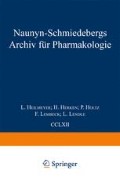Summary
The binding of tritium-labelled ouabain, digoxin, digitoxin and digitoxigenin to serum proteins was investigated in vitro by means of the Sephadex Gelfiltration method.
There is no difference in the binding characteristics of human serum and 4% solutions of human or bovine albumin with respect to cardiac glycosides. In a concentration of 2.5 X 10−7 g/ml, which is within the therapeutic range, less than 5% of the ouabain, about 20% of the digoxin, 85% of the digitoxigenin and 93% of the digitoxin are bound to plasma proteins. In the range between 7 × 10−8 g/ml and 1 × 10−6 g/ml, a linear relationship exists between the binding to albumin and the concentration of the compounds. The binding constants K and the binding energies ΔF 0 were calculated. When therapeutic concentrations of cardiac glycosides are compared on a molar basis with the concentration of albumin, the latter is found to be in a large excess. Thus, there are relatively few albumin molecules to which the cardiac glycosides are attached. No competition between digitoxin and digitoxigenin for the albumin binding sites was observed.
Hydrophobic groups are of special interest in the binding of these drugs to plasma proteins.
Zusammenfassung
Die Bindung von 3H-markiertem g-Strophanthin, Digoxin, Digitoxin und Digitoxigenin an Serumproteine wurde mit Hilfe der Sephadex-Gelfiltration untersucht. Menschliches Serum, 4% ige Human- und 4% ige Rinderalbuminlösung unterscheiden sich in ihren Bindungseigenschaften nicht voneinander. Bei einer Konzentration von 2, 5 · 10−7 g/ml der herzwirksamen Substanz, also einer Konzentration im therapeutischen Bereich, liegen < 5% g-Strophanthin, ca. 20% Digoxin, ca. 85% Digitoxigenin und ca. 93% Digitoxin in proteingebundener Form vor. Die Bindung an Humanalbumin ist im Bereich von 7 · 10−8 bis 1 · 10−6 g/ml linear proportional der angebotenen Konzentration der Substanzen. Die Bindungskonstanten K und die freien Reaktionsenergien ΔF 0 der Bindung der verschiedenen Substanzen an Humanalbumin wurden berechnet.
In therapeutischen Konzentrationen von Cardenoliden ist Albumin auch bei starker Bindung immer noch im großen molaren Überschuß vorhanden, so daß nur ein Bruchteil der Albuminmoleküle mit einem Molekül der Substanz reagiert. Kompetitionsphämonene zwischen Digitoxin und Digitoxigenin an Albumin sind daher nicht zu beobachten.
Hydrophobe Gruppen der herzwirksamen Substanzen spielen offensichtlich eine wichtige Rolle bei der Proteinbindung.
Access this chapter
Tax calculation will be finalised at checkout
Purchases are for personal use only
Preview
Unable to display preview. Download preview PDF.
Literatur
Büttner, H., u. F. Portwich: Kompetitionsphänomene bei der Bindung von Pharmaka an Albumin. Klin. Wschr. 45, 225 (1967).
Farah, A.: On the combination of some cardio-active glycosides with serum proteins. J. Pharmacol. exp. Ther. 83, 143 (1945).
Gilbert, G. A., and R. C. L. Jenkins: Sedimentation and electrophoresis of interacting substances: II. Asymptotic boundary shape for two substances interacting reversibly. Proc. roy Soc. A 253, 420 (1959).
Haarmann, W., A. Hagemeier u. L. Lendle: Über die Bindung von Digitalis-glykosiden und Digitaloiden an die Eiweißstoffe des Blutserums. Naunyn-Schmiedebergs Arch. exp. Path. Pharmak. 194, 205 (1940).
Krieglstein, J., u. G. Kuschinsky: Quantitative Bestimmung der Eiweißbindung von Pharmaka durch Gelfiltration. Arzneimittel-Forsch. 18, 287 (1968).
Kuschinsky, K.: Bestimmung der Eiweißbindung verschiedener Herzglykoside mittels Sephadex-Gelfiltration. Naunyn-Schmiedebergs Arch. Pharmak. exp. Path. 259, 394 (1968).
— H. Lahrtz, H. Lüllmann, and P. A. van Zwieten: Accumulation and release of 3H-digoxin by guinea pig heart muscle. Brit. J. Pharmacol. Chemother. 30, 317 (1967).
— H. Lüllmann u. P. A. van Zwieten: Über das Verhalten von Digoxin, Digitoxin und Digitoxigenin im isolierten Organsystem und im Plasma von Meerschweinchen nach Reserpin-Vorbehandlung. (In Vorbereitung.)
Kuschinsky, K., H. Lüllmann, and P. A. van Zwieten: A comparison of the accumulation and release of 3H-ouabain and 3H-digitoxin by guinea pig heart muscle. Brit. J. Pharmacol. Chemother. 32, 598 (1968a).
P. A. van Zwieten — — The binding of 3H-digitoxigenin by guinea pig atria tissue. Brit. J. Pharmacol. Chemother. 34, 613 (1968b).
Nichol, L. W., and D. J. Winzor: The determination of equilibrium constants from transport data on rapidly reacting systems of the type A + B ⇄ C. J. phys. Chem. 68, 2455 (1964).
Saris, N. E.: Acta chem. scand. 17, 3 (1963); zit. nach W. Scholtan: Arzneimittel-Forsch. 14, 146 (1964).
Scatchard, G.: The attractions of proteins for small molecules and ions. Ann. N. Y. Acad. Sci. 51, 660 (1949).
Scholtan, W.: Vergleichende quantitative Bestimmung der Eiweißbindung von Chemotherapeutica mittels Sephadex und Dialyse. Arzneimittel-Forsch. 14, 146 (1964).
— Die hydrophobe Bindung der Pharmaka an Humanalbumin und Ribonuclein-Säure. Arzneimittel-Forsch. 18, 505 (1968).
— K. Schlossmann u. H. Kosenkranz: Bestimmung der Eiweißbindung von Digitalis-Präparaten mittels der Ultrazentrifuge. Arzneimittel-Forsch. 16, 109 (1966).
Author information
Authors and Affiliations
Editor information
Editors and Affiliations
Rights and permissions
Copyright information
© 1969 Springer-Verlag Berlin Heidelberg
About this chapter
Cite this chapter
Kuschinsky, K. (1969). Über die Bindungseigenschaften von Plasmaproteinen für Herzglykoside. In: Habermann, E., et al. Naunyn Schmiedebergs Archiv für Pharmakologie. Springer, Berlin, Heidelberg. https://doi.org/10.1007/978-3-662-39718-3_30
Download citation
DOI: https://doi.org/10.1007/978-3-662-39718-3_30
Publisher Name: Springer, Berlin, Heidelberg
Print ISBN: 978-3-662-38809-9
Online ISBN: 978-3-662-39718-3
eBook Packages: Springer Book Archive

